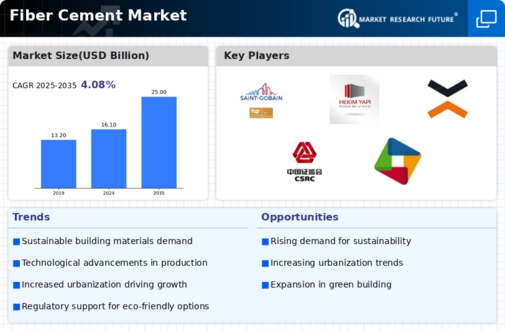-
EXECUTIVE SUMMARY
-
Market Overview
-
Key Findings
-
Market Segmentation
-
Competitive Landscape
-
Challenges and Opportunities
-
Future Outlook
-
MARKET INTRODUCTION
-
Definition
-
Scope of the study
- Research Objective
- Assumption
- Limitations
-
RESEARCH METHODOLOGY
-
Overview
-
Data Mining
-
Secondary Research
-
Primary Research
- Primary Interviews and Information Gathering Process
- Breakdown of Primary Respondents
-
Forecasting Model
-
Market Size Estimation
- Bottom-Up Approach
- Top-Down Approach
-
Data Triangulation
-
Validation
-
MARKET DYNAMICS
-
Overview
-
Drivers
-
Restraints
-
Opportunities
-
MARKET FACTOR ANALYSIS
-
Value chain Analysis
-
Porter's Five Forces Analysis
- Bargaining Power of Suppliers
- Bargaining Power of Buyers
- Threat of New Entrants
- Threat of Substitutes
- Intensity of Rivalry
-
COVID-19 Impact Analysis
- Market Impact Analysis
- Regional Impact
- Opportunity and Threat Analysis
-
FIBER CEMENT MARKET, BY APPLICATION (USD BILLION)
-
Siding
-
Roofing
-
Flooring
-
Interior Walls
-
Precast Structures
-
FIBER CEMENT MARKET, BY END USE (USD BILLION)
-
Residential
-
Commercial
-
Industrial
-
FIBER CEMENT MARKET, BY PRODUCT TYPE (USD BILLION)
-
Fiber Cement Board
-
Fiber Cement Slab
-
Fiber Cement Panel
-
FIBER CEMENT MARKET, BY MANUFACTURING PROCESS (USD BILLION)
-
Semi-Dry Process
-
Wet Process
-
Other Processes
-
FIBER CEMENT MARKET, BY REGIONAL (USD BILLION)
-
North America
- US
- Canada
-
Europe
- Germany
- UK
- France
- Russia
- Italy
- Spain
- Rest of Europe
-
APAC
- China
- India
- Japan
- South Korea
- Malaysia
- Thailand
- Indonesia
- Rest of APAC
-
South America
- Brazil
- Mexico
- Argentina
- Rest of South America
-
MEA
- GCC Countries
- South Africa
- Rest of MEA
-
COMPETITIVE LANDSCAPE
-
Overview
-
Competitive Analysis
-
Market share Analysis
-
Major Growth Strategy in the Fiber Cement Market
-
Competitive Benchmarking
-
Leading Players in Terms of Number of Developments in the Fiber Cement Market
-
Key developments and growth strategies
- New Product Launch/Service Deployment
- Merger & Acquisitions
- Joint Ventures
-
Major Players Financial Matrix
- Sales and Operating Income
- Major Players R&D Expenditure. 2023
-
COMPANY PROFILES
-
James Hardie Industries
- Financial Overview
- Products Offered
- Key Developments
- SWOT Analysis
- Key Strategies
-
SaintGobain
- Financial Overview
- Products Offered
- Key Developments
- SWOT Analysis
- Key Strategies
-
Fiber Cement Technologies
- Financial Overview
- Products Offered
- Key Developments
- SWOT Analysis
- Key Strategies
-
Allura
- Financial Overview
- Products Offered
- Key Developments
- SWOT Analysis
- Key Strategies
-
Toray Industries
- Financial Overview
- Products Offered
- Key Developments
- SWOT Analysis
- Key Strategies
-
Etex Group
- Financial Overview
- Products Offered
- Key Developments
- SWOT Analysis
- Key Strategies
-
Cement Board Services
- Financial Overview
- Products Offered
- Key Developments
- SWOT Analysis
- Key Strategies
-
Cembrit Holding
- Financial Overview
- Products Offered
- Key Developments
- SWOT Analysis
- Key Strategies
-
Owens Corning
- Financial Overview
- Products Offered
- Key Developments
- SWOT Analysis
- Key Strategies
-
GAF Materials Corporation
- Financial Overview
- Products Offered
- Key Developments
- SWOT Analysis
- Key Strategies
-
Celltech Metals
- Financial Overview
- Products Offered
- Key Developments
- SWOT Analysis
- Key Strategies
-
Tegral Building Products
- Financial Overview
- Products Offered
- Key Developments
- SWOT Analysis
- Key Strategies
-
Hume Cemboard Industries
- Financial Overview
- Products Offered
- Key Developments
- SWOT Analysis
- Key Strategies
-
SCG Building Materials
- Financial Overview
- Products Offered
- Key Developments
- SWOT Analysis
- Key Strategies
-
Nichiha Corporation
- Financial Overview
- Products Offered
- Key Developments
- SWOT Analysis
- Key Strategies
-
APPENDIX
-
References
-
Related Reports
-
LIST OF TABLES
-
LIST OF ASSUMPTIONS
-
NORTH AMERICA FIBER CEMENT MARKET SIZE ESTIMATES & FORECAST, BY APPLICATION, 2019-2035 (USD BILLIONS)
-
NORTH AMERICA FIBER CEMENT MARKET SIZE ESTIMATES & FORECAST, BY END USE, 2019-2035 (USD BILLIONS)
-
NORTH AMERICA FIBER CEMENT MARKET SIZE ESTIMATES & FORECAST, BY PRODUCT TYPE, 2019-2035 (USD BILLIONS)
-
NORTH AMERICA FIBER CEMENT MARKET SIZE ESTIMATES & FORECAST, BY MANUFACTURING PROCESS, 2019-2035 (USD BILLIONS)
-
NORTH AMERICA FIBER CEMENT MARKET SIZE ESTIMATES & FORECAST, BY REGIONAL, 2019-2035 (USD BILLIONS)
-
US FIBER CEMENT MARKET SIZE ESTIMATES & FORECAST, BY APPLICATION, 2019-2035 (USD BILLIONS)
-
US FIBER CEMENT MARKET SIZE ESTIMATES & FORECAST, BY END USE, 2019-2035 (USD BILLIONS)
-
US FIBER CEMENT MARKET SIZE ESTIMATES & FORECAST, BY PRODUCT TYPE, 2019-2035 (USD BILLIONS)
-
US FIBER CEMENT MARKET SIZE ESTIMATES & FORECAST, BY MANUFACTURING PROCESS, 2019-2035 (USD BILLIONS)
-
US FIBER CEMENT MARKET SIZE ESTIMATES & FORECAST, BY REGIONAL, 2019-2035 (USD BILLIONS)
-
CANADA FIBER CEMENT MARKET SIZE ESTIMATES & FORECAST, BY APPLICATION, 2019-2035 (USD BILLIONS)
-
CANADA FIBER CEMENT MARKET SIZE ESTIMATES & FORECAST, BY END USE, 2019-2035 (USD BILLIONS)
-
CANADA FIBER CEMENT MARKET SIZE ESTIMATES & FORECAST, BY PRODUCT TYPE, 2019-2035 (USD BILLIONS)
-
CANADA FIBER CEMENT MARKET SIZE ESTIMATES & FORECAST, BY MANUFACTURING PROCESS, 2019-2035 (USD BILLIONS)
-
CANADA FIBER CEMENT MARKET SIZE ESTIMATES & FORECAST, BY REGIONAL, 2019-2035 (USD BILLIONS)
-
EUROPE FIBER CEMENT MARKET SIZE ESTIMATES & FORECAST, BY APPLICATION, 2019-2035 (USD BILLIONS)
-
EUROPE FIBER CEMENT MARKET SIZE ESTIMATES & FORECAST, BY END USE, 2019-2035 (USD BILLIONS)
-
EUROPE FIBER CEMENT MARKET SIZE ESTIMATES & FORECAST, BY PRODUCT TYPE, 2019-2035 (USD BILLIONS)
-
EUROPE FIBER CEMENT MARKET SIZE ESTIMATES & FORECAST, BY MANUFACTURING PROCESS, 2019-2035 (USD BILLIONS)
-
EUROPE FIBER CEMENT MARKET SIZE ESTIMATES & FORECAST, BY REGIONAL, 2019-2035 (USD BILLIONS)
-
GERMANY FIBER CEMENT MARKET SIZE ESTIMATES & FORECAST, BY APPLICATION, 2019-2035 (USD BILLIONS)
-
GERMANY FIBER CEMENT MARKET SIZE ESTIMATES & FORECAST, BY END USE, 2019-2035 (USD BILLIONS)
-
GERMANY FIBER CEMENT MARKET SIZE ESTIMATES & FORECAST, BY PRODUCT TYPE, 2019-2035 (USD BILLIONS)
-
GERMANY FIBER CEMENT MARKET SIZE ESTIMATES & FORECAST, BY MANUFACTURING PROCESS, 2019-2035 (USD BILLIONS)
-
GERMANY FIBER CEMENT MARKET SIZE ESTIMATES & FORECAST, BY REGIONAL, 2019-2035 (USD BILLIONS)
-
UK FIBER CEMENT MARKET SIZE ESTIMATES & FORECAST, BY APPLICATION, 2019-2035 (USD BILLIONS)
-
UK FIBER CEMENT MARKET SIZE ESTIMATES & FORECAST, BY END USE, 2019-2035 (USD BILLIONS)
-
UK FIBER CEMENT MARKET SIZE ESTIMATES & FORECAST, BY PRODUCT TYPE, 2019-2035 (USD BILLIONS)
-
UK FIBER CEMENT MARKET SIZE ESTIMATES & FORECAST, BY MANUFACTURING PROCESS, 2019-2035 (USD BILLIONS)
-
UK FIBER CEMENT MARKET SIZE ESTIMATES & FORECAST, BY REGIONAL, 2019-2035 (USD BILLIONS)
-
FRANCE FIBER CEMENT MARKET SIZE ESTIMATES & FORECAST, BY APPLICATION, 2019-2035 (USD BILLIONS)
-
FRANCE FIBER CEMENT MARKET SIZE ESTIMATES & FORECAST, BY END USE, 2019-2035 (USD BILLIONS)
-
FRANCE FIBER CEMENT MARKET SIZE ESTIMATES & FORECAST, BY PRODUCT TYPE, 2019-2035 (USD BILLIONS)
-
FRANCE FIBER CEMENT MARKET SIZE ESTIMATES & FORECAST, BY MANUFACTURING PROCESS, 2019-2035 (USD BILLIONS)
-
FRANCE FIBER CEMENT MARKET SIZE ESTIMATES & FORECAST, BY REGIONAL, 2019-2035 (USD BILLIONS)
-
RUSSIA FIBER CEMENT MARKET SIZE ESTIMATES & FORECAST, BY APPLICATION, 2019-2035 (USD BILLIONS)
-
RUSSIA FIBER CEMENT MARKET SIZE ESTIMATES & FORECAST, BY END USE, 2019-2035 (USD BILLIONS)
-
RUSSIA FIBER CEMENT MARKET SIZE ESTIMATES & FORECAST, BY PRODUCT TYPE, 2019-2035 (USD BILLIONS)
-
RUSSIA FIBER CEMENT MARKET SIZE ESTIMATES & FORECAST, BY MANUFACTURING PROCESS, 2019-2035 (USD BILLIONS)
-
RUSSIA FIBER CEMENT MARKET SIZE ESTIMATES & FORECAST, BY REGIONAL, 2019-2035 (USD BILLIONS)
-
ITALY FIBER CEMENT MARKET SIZE ESTIMATES & FORECAST, BY APPLICATION, 2019-2035 (USD BILLIONS)
-
ITALY FIBER CEMENT MARKET SIZE ESTIMATES & FORECAST, BY END USE, 2019-2035 (USD BILLIONS)
-
ITALY FIBER CEMENT MARKET SIZE ESTIMATES & FORECAST, BY PRODUCT TYPE, 2019-2035 (USD BILLIONS)
-
ITALY FIBER CEMENT MARKET SIZE ESTIMATES & FORECAST, BY MANUFACTURING PROCESS, 2019-2035 (USD BILLIONS)
-
ITALY FIBER CEMENT MARKET SIZE ESTIMATES & FORECAST, BY REGIONAL, 2019-2035 (USD BILLIONS)
-
SPAIN FIBER CEMENT MARKET SIZE ESTIMATES & FORECAST, BY APPLICATION, 2019-2035 (USD BILLIONS)
-
SPAIN FIBER CEMENT MARKET SIZE ESTIMATES & FORECAST, BY END USE, 2019-2035 (USD BILLIONS)
-
SPAIN FIBER CEMENT MARKET SIZE ESTIMATES & FORECAST, BY PRODUCT TYPE, 2019-2035 (USD BILLIONS)
-
SPAIN FIBER CEMENT MARKET SIZE ESTIMATES & FORECAST, BY MANUFACTURING PROCESS, 2019-2035 (USD BILLIONS)
-
SPAIN FIBER CEMENT MARKET SIZE ESTIMATES & FORECAST, BY REGIONAL, 2019-2035 (USD BILLIONS)
-
REST OF EUROPE FIBER CEMENT MARKET SIZE ESTIMATES & FORECAST, BY APPLICATION, 2019-2035 (USD BILLIONS)
-
REST OF EUROPE FIBER CEMENT MARKET SIZE ESTIMATES & FORECAST, BY END USE, 2019-2035 (USD BILLIONS)
-
REST OF EUROPE FIBER CEMENT MARKET SIZE ESTIMATES & FORECAST, BY PRODUCT TYPE, 2019-2035 (USD BILLIONS)
-
REST OF EUROPE FIBER CEMENT MARKET SIZE ESTIMATES & FORECAST, BY MANUFACTURING PROCESS, 2019-2035 (USD BILLIONS)
-
REST OF EUROPE FIBER CEMENT MARKET SIZE ESTIMATES & FORECAST, BY REGIONAL, 2019-2035 (USD BILLIONS)
-
APAC FIBER CEMENT MARKET SIZE ESTIMATES & FORECAST, BY APPLICATION, 2019-2035 (USD BILLIONS)
-
APAC FIBER CEMENT MARKET SIZE ESTIMATES & FORECAST, BY END USE, 2019-2035 (USD BILLIONS)
-
APAC FIBER CEMENT MARKET SIZE ESTIMATES & FORECAST, BY PRODUCT TYPE, 2019-2035 (USD BILLIONS)
-
APAC FIBER CEMENT MARKET SIZE ESTIMATES & FORECAST, BY MANUFACTURING PROCESS, 2019-2035 (USD BILLIONS)
-
APAC FIBER CEMENT MARKET SIZE ESTIMATES & FORECAST, BY REGIONAL, 2019-2035 (USD BILLIONS)
-
CHINA FIBER CEMENT MARKET SIZE ESTIMATES & FORECAST, BY APPLICATION, 2019-2035 (USD BILLIONS)
-
CHINA FIBER CEMENT MARKET SIZE ESTIMATES & FORECAST, BY END USE, 2019-2035 (USD BILLIONS)
-
CHINA FIBER CEMENT MARKET SIZE ESTIMATES & FORECAST, BY PRODUCT TYPE, 2019-2035 (USD BILLIONS)
-
CHINA FIBER CEMENT MARKET SIZE ESTIMATES & FORECAST, BY MANUFACTURING PROCESS, 2019-2035 (USD BILLIONS)
-
CHINA FIBER CEMENT MARKET SIZE ESTIMATES & FORECAST, BY REGIONAL, 2019-2035 (USD BILLIONS)
-
INDIA FIBER CEMENT MARKET SIZE ESTIMATES & FORECAST, BY APPLICATION, 2019-2035 (USD BILLIONS)
-
INDIA FIBER CEMENT MARKET SIZE ESTIMATES & FORECAST, BY END USE, 2019-2035 (USD BILLIONS)
-
INDIA FIBER CEMENT MARKET SIZE ESTIMATES & FORECAST, BY PRODUCT TYPE, 2019-2035 (USD BILLIONS)
-
INDIA FIBER CEMENT MARKET SIZE ESTIMATES & FORECAST, BY MANUFACTURING PROCESS, 2019-2035 (USD BILLIONS)
-
INDIA FIBER CEMENT MARKET SIZE ESTIMATES & FORECAST, BY REGIONAL, 2019-2035 (USD BILLIONS)
-
JAPAN FIBER CEMENT MARKET SIZE ESTIMATES & FORECAST, BY APPLICATION, 2019-2035 (USD BILLIONS)
-
JAPAN FIBER CEMENT MARKET SIZE ESTIMATES & FORECAST, BY END USE, 2019-2035 (USD BILLIONS)
-
JAPAN FIBER CEMENT MARKET SIZE ESTIMATES & FORECAST, BY PRODUCT TYPE, 2019-2035 (USD BILLIONS)
-
JAPAN FIBER CEMENT MARKET SIZE ESTIMATES & FORECAST, BY MANUFACTURING PROCESS, 2019-2035 (USD BILLIONS)
-
JAPAN FIBER CEMENT MARKET SIZE ESTIMATES & FORECAST, BY REGIONAL, 2019-2035 (USD BILLIONS)
-
SOUTH KOREA FIBER CEMENT MARKET SIZE ESTIMATES & FORECAST, BY APPLICATION, 2019-2035 (USD BILLIONS)
-
SOUTH KOREA FIBER CEMENT MARKET SIZE ESTIMATES & FORECAST, BY END USE, 2019-2035 (USD BILLIONS)
-
SOUTH KOREA FIBER CEMENT MARKET SIZE ESTIMATES & FORECAST, BY PRODUCT TYPE, 2019-2035 (USD BILLIONS)
-
SOUTH KOREA FIBER CEMENT MARKET SIZE ESTIMATES & FORECAST, BY MANUFACTURING PROCESS, 2019-2035 (USD BILLIONS)
-
SOUTH KOREA FIBER CEMENT MARKET SIZE ESTIMATES & FORECAST, BY REGIONAL, 2019-2035 (USD BILLIONS)
-
MALAYSIA FIBER CEMENT MARKET SIZE ESTIMATES & FORECAST, BY APPLICATION, 2019-2035 (USD BILLIONS)
-
MALAYSIA FIBER CEMENT MARKET SIZE ESTIMATES & FORECAST, BY END USE, 2019-2035 (USD BILLIONS)
-
MALAYSIA FIBER CEMENT MARKET SIZE ESTIMATES & FORECAST, BY PRODUCT TYPE, 2019-2035 (USD BILLIONS)
-
MALAYSIA FIBER CEMENT MARKET SIZE ESTIMATES & FORECAST, BY MANUFACTURING PROCESS, 2019-2035 (USD BILLIONS)
-
MALAYSIA FIBER CEMENT MARKET SIZE ESTIMATES & FORECAST, BY REGIONAL, 2019-2035 (USD BILLIONS)
-
THAILAND FIBER CEMENT MARKET SIZE ESTIMATES & FORECAST, BY APPLICATION, 2019-2035 (USD BILLIONS)
-
THAILAND FIBER CEMENT MARKET SIZE ESTIMATES & FORECAST, BY END USE, 2019-2035 (USD BILLIONS)
-
THAILAND FIBER CEMENT MARKET SIZE ESTIMATES & FORECAST, BY PRODUCT TYPE, 2019-2035 (USD BILLIONS)
-
THAILAND FIBER CEMENT MARKET SIZE ESTIMATES & FORECAST, BY MANUFACTURING PROCESS, 2019-2035 (USD BILLIONS)
-
THAILAND FIBER CEMENT MARKET SIZE ESTIMATES & FORECAST, BY REGIONAL, 2019-2035 (USD BILLIONS)
-
INDONESIA FIBER CEMENT MARKET SIZE ESTIMATES & FORECAST, BY APPLICATION, 2019-2035 (USD BILLIONS)
-
INDONESIA FIBER CEMENT MARKET SIZE ESTIMATES & FORECAST, BY END USE, 2019-2035 (USD BILLIONS)
-
INDONESIA FIBER CEMENT MARKET SIZE ESTIMATES & FORECAST, BY PRODUCT TYPE, 2019-2035 (USD BILLIONS)
-
INDONESIA FIBER CEMENT MARKET SIZE ESTIMATES & FORECAST, BY MANUFACTURING PROCESS, 2019-2035 (USD BILLIONS)
-
INDONESIA FIBER CEMENT MARKET SIZE ESTIMATES & FORECAST, BY REGIONAL, 2019-2035 (USD BILLIONS)
-
REST OF APAC FIBER CEMENT MARKET SIZE ESTIMATES & FORECAST, BY APPLICATION, 2019-2035 (USD BILLIONS)
-
REST OF APAC FIBER CEMENT MARKET SIZE ESTIMATES & FORECAST, BY END USE, 2019-2035 (USD BILLIONS)
-
REST OF APAC FIBER CEMENT MARKET SIZE ESTIMATES & FORECAST, BY PRODUCT TYPE, 2019-2035 (USD BILLIONS)
-
REST OF APAC FIBER CEMENT MARKET SIZE ESTIMATES & FORECAST, BY MANUFACTURING PROCESS, 2019-2035 (USD BILLIONS)
-
REST OF APAC FIBER CEMENT MARKET SIZE ESTIMATES & FORECAST, BY REGIONAL, 2019-2035 (USD BILLIONS)
-
SOUTH AMERICA FIBER CEMENT MARKET SIZE ESTIMATES & FORECAST, BY APPLICATION, 2019-2035 (USD BILLIONS)
-
SOUTH AMERICA FIBER CEMENT MARKET SIZE ESTIMATES & FORECAST, BY END USE, 2019-2035 (USD BILLIONS)
-
SOUTH AMERICA FIBER CEMENT MARKET SIZE ESTIMATES & FORECAST, BY PRODUCT TYPE, 2019-2035 (USD BILLIONS)
-
SOUTH AMERICA FIBER CEMENT MARKET SIZE ESTIMATES & FORECAST, BY MANUFACTURING PROCESS, 2019-2035 (USD BILLIONS)
-
SOUTH AMERICA FIBER CEMENT MARKET SIZE ESTIMATES & FORECAST, BY REGIONAL, 2019-2035 (USD BILLIONS)
-
BRAZIL FIBER CEMENT MARKET SIZE ESTIMATES & FORECAST, BY APPLICATION, 2019-2035 (USD BILLIONS)
-
BRAZIL FIBER CEMENT MARKET SIZE ESTIMATES & FORECAST, BY END USE, 2019-2035 (USD BILLIONS)
-
BRAZIL FIBER CEMENT MARKET SIZE ESTIMATES & FORECAST, BY PRODUCT TYPE, 2019-2035 (USD BILLIONS)
-
BRAZIL FIBER CEMENT MARKET SIZE ESTIMATES & FORECAST, BY MANUFACTURING PROCESS, 2019-2035 (USD BILLIONS)
-
BRAZIL FIBER CEMENT MARKET SIZE ESTIMATES & FORECAST, BY REGIONAL, 2019-2035 (USD BILLIONS)
-
MEXICO FIBER CEMENT MARKET SIZE ESTIMATES & FORECAST, BY APPLICATION, 2019-2035 (USD BILLIONS)
-
MEXICO FIBER CEMENT MARKET SIZE ESTIMATES & FORECAST, BY END USE, 2019-2035 (USD BILLIONS)
-
MEXICO FIBER CEMENT MARKET SIZE ESTIMATES & FORECAST, BY PRODUCT TYPE, 2019-2035 (USD BILLIONS)
-
MEXICO FIBER CEMENT MARKET SIZE ESTIMATES & FORECAST, BY MANUFACTURING PROCESS, 2019-2035 (USD BILLIONS)
-
MEXICO FIBER CEMENT MARKET SIZE ESTIMATES & FORECAST, BY REGIONAL, 2019-2035 (USD BILLIONS)
-
ARGENTINA FIBER CEMENT MARKET SIZE ESTIMATES & FORECAST, BY APPLICATION, 2019-2035 (USD BILLIONS)
-
ARGENTINA FIBER CEMENT MARKET SIZE ESTIMATES & FORECAST, BY END USE, 2019-2035 (USD BILLIONS)
-
ARGENTINA FIBER CEMENT MARKET SIZE ESTIMATES & FORECAST, BY PRODUCT TYPE, 2019-2035 (USD BILLIONS)
-
ARGENTINA FIBER CEMENT MARKET SIZE ESTIMATES & FORECAST, BY MANUFACTURING PROCESS, 2019-2035 (USD BILLIONS)
-
ARGENTINA FIBER CEMENT MARKET SIZE ESTIMATES & FORECAST, BY REGIONAL, 2019-2035 (USD BILLIONS)
-
REST OF SOUTH AMERICA FIBER CEMENT MARKET SIZE ESTIMATES & FORECAST, BY APPLICATION, 2019-2035 (USD BILLIONS)
-
REST OF SOUTH AMERICA FIBER CEMENT MARKET SIZE ESTIMATES & FORECAST, BY END USE, 2019-2035 (USD BILLIONS)
-
REST OF SOUTH AMERICA FIBER CEMENT MARKET SIZE ESTIMATES & FORECAST, BY PRODUCT TYPE, 2019-2035 (USD BILLIONS)
-
REST OF SOUTH AMERICA FIBER CEMENT MARKET SIZE ESTIMATES & FORECAST, BY MANUFACTURING PROCESS, 2019-2035 (USD BILLIONS)
-
REST OF SOUTH AMERICA FIBER CEMENT MARKET SIZE ESTIMATES & FORECAST, BY REGIONAL, 2019-2035 (USD BILLIONS)
-
MEA FIBER CEMENT MARKET SIZE ESTIMATES & FORECAST, BY APPLICATION, 2019-2035 (USD BILLIONS)
-
MEA FIBER CEMENT MARKET SIZE ESTIMATES & FORECAST, BY END USE, 2019-2035 (USD BILLIONS)
-
MEA FIBER CEMENT MARKET SIZE ESTIMATES & FORECAST, BY PRODUCT TYPE, 2019-2035 (USD BILLIONS)
-
MEA FIBER CEMENT MARKET SIZE ESTIMATES & FORECAST, BY MANUFACTURING PROCESS, 2019-2035 (USD BILLIONS)
-
MEA FIBER CEMENT MARKET SIZE ESTIMATES & FORECAST, BY REGIONAL, 2019-2035 (USD BILLIONS)
-
GCC COUNTRIES FIBER CEMENT MARKET SIZE ESTIMATES & FORECAST, BY APPLICATION, 2019-2035 (USD BILLIONS)
-
GCC COUNTRIES FIBER CEMENT MARKET SIZE ESTIMATES & FORECAST, BY END USE, 2019-2035 (USD BILLIONS)
-
GCC COUNTRIES FIBER CEMENT MARKET SIZE ESTIMATES & FORECAST, BY PRODUCT TYPE, 2019-2035 (USD BILLIONS)
-
GCC COUNTRIES FIBER CEMENT MARKET SIZE ESTIMATES & FORECAST, BY MANUFACTURING PROCESS, 2019-2035 (USD BILLIONS)
-
GCC COUNTRIES FIBER CEMENT MARKET SIZE ESTIMATES & FORECAST, BY REGIONAL, 2019-2035 (USD BILLIONS)
-
SOUTH AFRICA FIBER CEMENT MARKET SIZE ESTIMATES & FORECAST, BY APPLICATION, 2019-2035 (USD BILLIONS)
-
SOUTH AFRICA FIBER CEMENT MARKET SIZE ESTIMATES & FORECAST, BY END USE, 2019-2035 (USD BILLIONS)
-
SOUTH AFRICA FIBER CEMENT MARKET SIZE ESTIMATES & FORECAST, BY PRODUCT TYPE, 2019-2035 (USD BILLIONS)
-
SOUTH AFRICA FIBER CEMENT MARKET SIZE ESTIMATES & FORECAST, BY MANUFACTURING PROCESS, 2019-2035 (USD BILLIONS)
-
SOUTH AFRICA FIBER CEMENT MARKET SIZE ESTIMATES & FORECAST, BY REGIONAL, 2019-2035 (USD BILLIONS)
-
REST OF MEA FIBER CEMENT MARKET SIZE ESTIMATES & FORECAST, BY APPLICATION, 2019-2035 (USD BILLIONS)
-
REST OF MEA FIBER CEMENT MARKET SIZE ESTIMATES & FORECAST, BY END USE, 2019-2035 (USD BILLIONS)
-
REST OF MEA FIBER CEMENT MARKET SIZE ESTIMATES & FORECAST, BY PRODUCT TYPE, 2019-2035 (USD BILLIONS)
-
REST OF MEA FIBER CEMENT MARKET SIZE ESTIMATES & FORECAST, BY MANUFACTURING PROCESS, 2019-2035 (USD BILLIONS)
-
REST OF MEA FIBER CEMENT MARKET SIZE ESTIMATES & FORECAST, BY REGIONAL, 2019-2035 (USD BILLIONS)
-
PRODUCT LAUNCH/PRODUCT DEVELOPMENT/APPROVAL
-
ACQUISITION/PARTNERSHIP
-
LIST OF FIGURES
-
MARKET SYNOPSIS
-
NORTH AMERICA FIBER CEMENT MARKET ANALYSIS
-
US FIBER CEMENT MARKET ANALYSIS BY APPLICATION
-
US FIBER CEMENT MARKET ANALYSIS BY END USE
-
US FIBER CEMENT MARKET ANALYSIS BY PRODUCT TYPE
-
US FIBER CEMENT MARKET ANALYSIS BY MANUFACTURING PROCESS
-
US FIBER CEMENT MARKET ANALYSIS BY REGIONAL
-
CANADA FIBER CEMENT MARKET ANALYSIS BY APPLICATION
-
CANADA FIBER CEMENT MARKET ANALYSIS BY END USE
-
CANADA FIBER CEMENT MARKET ANALYSIS BY PRODUCT TYPE
-
CANADA FIBER CEMENT MARKET ANALYSIS BY MANUFACTURING PROCESS
-
CANADA FIBER CEMENT MARKET ANALYSIS BY REGIONAL
-
EUROPE FIBER CEMENT MARKET ANALYSIS
-
GERMANY FIBER CEMENT MARKET ANALYSIS BY APPLICATION
-
GERMANY FIBER CEMENT MARKET ANALYSIS BY END USE
-
GERMANY FIBER CEMENT MARKET ANALYSIS BY PRODUCT TYPE
-
GERMANY FIBER CEMENT MARKET ANALYSIS BY MANUFACTURING PROCESS
-
GERMANY FIBER CEMENT MARKET ANALYSIS BY REGIONAL
-
UK FIBER CEMENT MARKET ANALYSIS BY APPLICATION
-
UK FIBER CEMENT MARKET ANALYSIS BY END USE
-
UK FIBER CEMENT MARKET ANALYSIS BY PRODUCT TYPE
-
UK FIBER CEMENT MARKET ANALYSIS BY MANUFACTURING PROCESS
-
UK FIBER CEMENT MARKET ANALYSIS BY REGIONAL
-
FRANCE FIBER CEMENT MARKET ANALYSIS BY APPLICATION
-
FRANCE FIBER CEMENT MARKET ANALYSIS BY END USE
-
FRANCE FIBER CEMENT MARKET ANALYSIS BY PRODUCT TYPE
-
FRANCE FIBER CEMENT MARKET ANALYSIS BY MANUFACTURING PROCESS
-
FRANCE FIBER CEMENT MARKET ANALYSIS BY REGIONAL
-
RUSSIA FIBER CEMENT MARKET ANALYSIS BY APPLICATION
-
RUSSIA FIBER CEMENT MARKET ANALYSIS BY END USE
-
RUSSIA FIBER CEMENT MARKET ANALYSIS BY PRODUCT TYPE
-
RUSSIA FIBER CEMENT MARKET ANALYSIS BY MANUFACTURING PROCESS
-
RUSSIA FIBER CEMENT MARKET ANALYSIS BY REGIONAL
-
ITALY FIBER CEMENT MARKET ANALYSIS BY APPLICATION
-
ITALY FIBER CEMENT MARKET ANALYSIS BY END USE
-
ITALY FIBER CEMENT MARKET ANALYSIS BY PRODUCT TYPE
-
ITALY FIBER CEMENT MARKET ANALYSIS BY MANUFACTURING PROCESS
-
ITALY FIBER CEMENT MARKET ANALYSIS BY REGIONAL
-
SPAIN FIBER CEMENT MARKET ANALYSIS BY APPLICATION
-
SPAIN FIBER CEMENT MARKET ANALYSIS BY END USE
-
SPAIN FIBER CEMENT MARKET ANALYSIS BY PRODUCT TYPE
-
SPAIN FIBER CEMENT MARKET ANALYSIS BY MANUFACTURING PROCESS
-
SPAIN FIBER CEMENT MARKET ANALYSIS BY REGIONAL
-
REST OF EUROPE FIBER CEMENT MARKET ANALYSIS BY APPLICATION
-
REST OF EUROPE FIBER CEMENT MARKET ANALYSIS BY END USE
-
REST OF EUROPE FIBER CEMENT MARKET ANALYSIS BY PRODUCT TYPE
-
REST OF EUROPE FIBER CEMENT MARKET ANALYSIS BY MANUFACTURING PROCESS
-
REST OF EUROPE FIBER CEMENT MARKET ANALYSIS BY REGIONAL
-
APAC FIBER CEMENT MARKET ANALYSIS
-
CHINA FIBER CEMENT MARKET ANALYSIS BY APPLICATION
-
CHINA FIBER CEMENT MARKET ANALYSIS BY END USE
-
CHINA FIBER CEMENT MARKET ANALYSIS BY PRODUCT TYPE
-
CHINA FIBER CEMENT MARKET ANALYSIS BY MANUFACTURING PROCESS
-
CHINA FIBER CEMENT MARKET ANALYSIS BY REGIONAL
-
INDIA FIBER CEMENT MARKET ANALYSIS BY APPLICATION
-
INDIA FIBER CEMENT MARKET ANALYSIS BY END USE
-
INDIA FIBER CEMENT MARKET ANALYSIS BY PRODUCT TYPE
-
INDIA FIBER CEMENT MARKET ANALYSIS BY MANUFACTURING PROCESS
-
INDIA FIBER CEMENT MARKET ANALYSIS BY REGIONAL
-
JAPAN FIBER CEMENT MARKET ANALYSIS BY APPLICATION
-
JAPAN FIBER CEMENT MARKET ANALYSIS BY END USE
-
JAPAN FIBER CEMENT MARKET ANALYSIS BY PRODUCT TYPE
-
JAPAN FIBER CEMENT MARKET ANALYSIS BY MANUFACTURING PROCESS
-
JAPAN FIBER CEMENT MARKET ANALYSIS BY REGIONAL
-
SOUTH KOREA FIBER CEMENT MARKET ANALYSIS BY APPLICATION
-
SOUTH KOREA FIBER CEMENT MARKET ANALYSIS BY END USE
-
SOUTH KOREA FIBER CEMENT MARKET ANALYSIS BY PRODUCT TYPE
-
SOUTH KOREA FIBER CEMENT MARKET ANALYSIS BY MANUFACTURING PROCESS
-
SOUTH KOREA FIBER CEMENT MARKET ANALYSIS BY REGIONAL
-
MALAYSIA FIBER CEMENT MARKET ANALYSIS BY APPLICATION
-
MALAYSIA FIBER CEMENT MARKET ANALYSIS BY END USE
-
MALAYSIA FIBER CEMENT MARKET ANALYSIS BY PRODUCT TYPE
-
MALAYSIA FIBER CEMENT MARKET ANALYSIS BY MANUFACTURING PROCESS
-
MALAYSIA FIBER CEMENT MARKET ANALYSIS BY REGIONAL
-
THAILAND FIBER CEMENT MARKET ANALYSIS BY APPLICATION
-
THAILAND FIBER CEMENT MARKET ANALYSIS BY END USE
-
THAILAND FIBER CEMENT MARKET ANALYSIS BY PRODUCT TYPE
-
THAILAND FIBER CEMENT MARKET ANALYSIS BY MANUFACTURING PROCESS
-
THAILAND FIBER CEMENT MARKET ANALYSIS BY REGIONAL
-
INDONESIA FIBER CEMENT MARKET ANALYSIS BY APPLICATION
-
INDONESIA FIBER CEMENT MARKET ANALYSIS BY END USE
-
INDONESIA FIBER CEMENT MARKET ANALYSIS BY PRODUCT TYPE
-
INDONESIA FIBER CEMENT MARKET ANALYSIS BY MANUFACTURING PROCESS
-
INDONESIA FIBER CEMENT MARKET ANALYSIS BY REGIONAL
-
REST OF APAC FIBER CEMENT MARKET ANALYSIS BY APPLICATION
-
REST OF APAC FIBER CEMENT MARKET ANALYSIS BY END USE
-
REST OF APAC FIBER CEMENT MARKET ANALYSIS BY PRODUCT TYPE
-
REST OF APAC FIBER CEMENT MARKET ANALYSIS BY MANUFACTURING PROCESS
-
REST OF APAC FIBER CEMENT MARKET ANALYSIS BY REGIONAL
-
SOUTH AMERICA FIBER CEMENT MARKET ANALYSIS
-
BRAZIL FIBER CEMENT MARKET ANALYSIS BY APPLICATION
-
BRAZIL FIBER CEMENT MARKET ANALYSIS BY END USE
-
BRAZIL FIBER CEMENT MARKET ANALYSIS BY PRODUCT TYPE
-
BRAZIL FIBER CEMENT MARKET ANALYSIS BY MANUFACTURING PROCESS
-
BRAZIL FIBER CEMENT MARKET ANALYSIS BY REGIONAL
-
MEXICO FIBER CEMENT MARKET ANALYSIS BY APPLICATION
-
MEXICO FIBER CEMENT MARKET ANALYSIS BY END USE
-
MEXICO FIBER CEMENT MARKET ANALYSIS BY PRODUCT TYPE
-
MEXICO FIBER CEMENT MARKET ANALYSIS BY MANUFACTURING PROCESS
-
MEXICO FIBER CEMENT MARKET ANALYSIS BY REGIONAL
-
ARGENTINA FIBER CEMENT MARKET ANALYSIS BY APPLICATION
-
ARGENTINA FIBER CEMENT MARKET ANALYSIS BY END USE
-
ARGENTINA FIBER CEMENT MARKET ANALYSIS BY PRODUCT TYPE
-
ARGENTINA FIBER CEMENT MARKET ANALYSIS BY MANUFACTURING PROCESS
-
ARGENTINA FIBER CEMENT MARKET ANALYSIS BY REGIONAL
-
REST OF SOUTH AMERICA FIBER CEMENT MARKET ANALYSIS BY APPLICATION
-
REST OF SOUTH AMERICA FIBER CEMENT MARKET ANALYSIS BY END USE
-
REST OF SOUTH AMERICA FIBER CEMENT MARKET ANALYSIS BY PRODUCT TYPE
-
REST OF SOUTH AMERICA FIBER CEMENT MARKET ANALYSIS BY MANUFACTURING PROCESS
-
REST OF SOUTH AMERICA FIBER CEMENT MARKET ANALYSIS BY REGIONAL
-
MEA FIBER CEMENT MARKET ANALYSIS
-
GCC COUNTRIES FIBER CEMENT MARKET ANALYSIS BY APPLICATION
-
GCC COUNTRIES FIBER CEMENT MARKET ANALYSIS BY END USE
-
GCC COUNTRIES FIBER CEMENT MARKET ANALYSIS BY PRODUCT TYPE
-
GCC COUNTRIES FIBER CEMENT MARKET ANALYSIS BY MANUFACTURING PROCESS
-
GCC COUNTRIES FIBER CEMENT MARKET ANALYSIS BY REGIONAL
-
SOUTH AFRICA FIBER CEMENT MARKET ANALYSIS BY APPLICATION
-
SOUTH AFRICA FIBER CEMENT MARKET ANALYSIS BY END USE
-
SOUTH AFRICA FIBER CEMENT MARKET ANALYSIS BY PRODUCT TYPE
-
SOUTH AFRICA FIBER CEMENT MARKET ANALYSIS BY MANUFACTURING PROCESS
-
SOUTH AFRICA FIBER CEMENT MARKET ANALYSIS BY REGIONAL
-
REST OF MEA FIBER CEMENT MARKET ANALYSIS BY APPLICATION
-
REST OF MEA FIBER CEMENT MARKET ANALYSIS BY END USE
-
REST OF MEA FIBER CEMENT MARKET ANALYSIS BY PRODUCT TYPE
-
REST OF MEA FIBER CEMENT MARKET ANALYSIS BY MANUFACTURING PROCESS
-
REST OF MEA FIBER CEMENT MARKET ANALYSIS BY REGIONAL
-
KEY BUYING CRITERIA OF FIBER CEMENT MARKET
-
RESEARCH PROCESS OF MRFR
-
DRO ANALYSIS OF FIBER CEMENT MARKET
-
DRIVERS IMPACT AN
















Leave a Comment